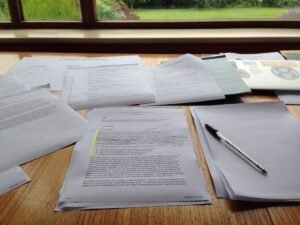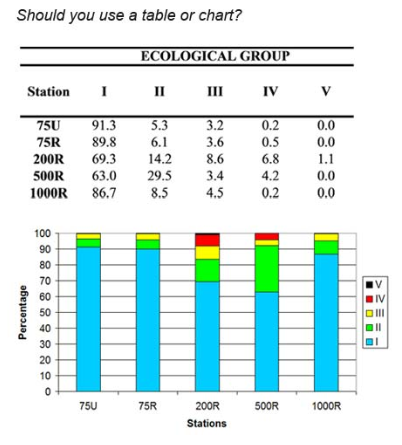Before diving headlong into writing a scientific article/journal. It is very important to prepare your scientific paper. This course overlaps slightly with the next one on writing scientific papers, but you might as well have the information twice to assimilate it well!

Page contents
TogglePrepare your scientific paper, know its structure
An article begins with the title, abstract and keywords.
The text of the article follows the IMRAD format, which meets the questions below :
- Introduction : What did you do/what did others do? Why did you do it?
- Methods : How did you do ?
- Results : what did you find?
- And
- Discussion: What does all this mean?
The main text is followed by the conclusion, acknowledgments, references and supporting documents.
First step, prepare your materials (figures, tables, etc.)
Remember that “a number is worth a thousand words”. Therefore, illustrations, including figures and tables, are the most effective way to present your results.
Whatever your choice, no illustration should reproduce information described elsewhere in the manuscript.

The material must be self-contained, that is to say it is possible to understand its content even without relying on the text (be careful, all material must still be discussed in the text!)

However, the figures should not be overloaded. Understanding the message of the material is essential.

I invite you to research on the site the courses of dataviz to find the right model for your data.

Prepare ideas (results, discussion, introduction, abstract then title)
At this stage, the scientific paper resembles a pile of puzzle pieces saturating each section with quantities of ideas. It is not uncommon that three-quarters of what you write will end up in LaTeX comments.
In order to see the message of your paper more clearly, it is important to finalize the results and the discussion. This makes it possible in particular to enrich its introduction and to establish the Abstract.
This section answers the question “What did you find?” » Therefore, only representative results of your research should be presented. The results should be central to the discussion.
For the data, decide on a logical order that tells a clear story and makes it easy to understand. Typically this will be in the same order as presented in the methods section.
An important issue is that you should not include references in this section; you are presenting your results, so you cannot refer to others here. If you are referring to others, it is because you are discussing your results, and this should be included in the Discussion section.
Same remark as for the results, writing the discussion will help in finalizing the other sections.
Here you need to answer what the results mean. This is probably the easiest section to write, but the hardest section to correct. This is because it is the most important section of your article. Here you have the option to sell your data.
You should do the Discussion corresponding to the Results, but do not repeat the results. Here you should compare your colleagues' published results with your own (using some of the references included in the introduction).
Never ignore work that disagrees with yours, in turn you must confront it and convince the reader that you are right or better.
Consider the following tips:
- Avoid statements that go beyond what the results can support.
- Avoid the sudden introduction of new terms or ideas; you must present everything in the introduction, to be confronted with your results here.
- Speculation about possible interpretations is permitted, but these must be rooted in fact rather than imagination
- How do these results relate to the original question or objectives described in the Introduction section?
- Does the data support your hypothesis?
- Are your results consistent with what other researchers have reported?
- Discuss weaknesses and gaps. If your results were unexpected, try to explain why
- Is there another way to interpret your results?
- What additional research would be needed to answer the questions raised by your results?
- Explain what is new without exaggerating
- Reviewing the results and discussion is not just paper work. You can do other experiments, derivations or simulations. Sometimes you cannot clarify your idea in words because some critical elements have not been studied substantively.
This is your opportunity to convince readers that you are clear about why your work is useful.
A good introduction should answer the following questions:
- What is the problem to be solved?
- Are there any existing solutions?
- What is the best ?
- What is its main limitation?
- What do you hope to achieve?
You should present the main scientific publications on which your work is based, citing some original and important works, including recent review articles.
The abstract tells potential readers what you did and what the important findings of your research were. With the title, it is the advertisement of your article. Make it interesting and easy to understand without reading the whole article. Avoid using jargon, abbreviations and unusual references.
You must be specific, using words that convey the precise meaning of your research. The abstract provides a brief description of the perspective and purpose of your article. It gives key results but minimizes experimental details. It is very important to remember that the summary offers a brief description of the interpretation/conclusion in the last sentence.
The title should explain the general subject of the document. This is your first (and probably only) opportunity to grab the reader's attention.
Here you can see some examples of original titles, and how they were changed after reviews and comments:
- Original title: Preliminary observations on the effect of salinity on the distribution of benthic communities within an estuarine system, in the North Sea
- Revised title: Effect of salinity on benthic distribution in the Scheldt estuary (North Sea)
- Comments: The long title distracts readers. Remove all redundancies such as “studies on”, “nature of”, etc. Never use phrases like “preliminary.” Be precise.
Another example :
- Original title: Action of antibiotics on bacteria
- Revised title: Inhibition of growth of Mycobacterium tuberculosis by streptomycin
- Comments: Titles must be precise. Think about “how will I search for this information” when designing the title.
Another one for the road:
- Original title: Fabrication of coaxial carbon/CdS nanofibers exhibiting optical and electrical properties via electrospun carbon
- Revised title: Electrospinning of coaxial carbon/CdS nanofibers with optical and electrical properties
- Comments: The title makes no sense. All materials have properties of all varieties. You could examine my hair for its electrical and optical properties! You MUST be specific. I haven't read the paper but I suspect there is something special about these properties, otherwise why would you report them?
In addition to multiple rereadings to make the article as fluid as possible, you also have to find the key words, the Acknowledgments and find the most relevant references.
The first draft, the outline of the scientific paper to come
These drafts or drafts can be sequenced as follows:
You can work through the body in three main stages:
- Create a plan of what you want to say and in what order.
- Write a first draft to put your main ideas on paper.
- Write a second draft to clarify your arguments and make sure everything matches.
Before you begin, make a plan that outlines the main points you want to make and the order in which you will make them. This can help you remember how each part of the essay should relate to the other parts.
However, remember that the plan is not set in stone – don't be afraid to change the organization if necessary. Work on the structure of an essay begins before you start writing, but it continues as you write and continues even after you have finished writing the first draft.
As you write a certain section, if you have an idea for something elsewhere in the essay, take a few moments to add to your outline or make notes on your organizational plans.
Your goals in the first draft are to turn your rough ideas into viable arguments, add detail to those arguments, and get an idea of what the final product will actually look like.
Start wherever you want
Many writers don't start writing from the introduction, or even the first few body paragraphs. Start to write your essay where it feels most natural to do so.
Some writers may prefer to start with the easiest section to write, while others prefer to get the most difficult section out of the way first. Think about what material you need to clarify for yourself and consider starting there.
Tackle one idea at a time
Each paragraph should aim to focus on a central idea, giving evidence, explanations, and arguments related to that idea.
At the beginning of each paragraph, write a topic sentence that expresses the main point. Then, expand and expand on the topic sentence throughout the rest of the paragraph.
When you have said everything you need to say about the idea, move on to a new paragraph.
Keep your argument flexible
You may realize as you write that some of your ideas don't work as well as you thought. Don't give up on them too easily, but be prepared to change or abandon sections if you realize they don't make sense.
You'll also likely come up with new ideas that you hadn't yet thought of when writing the plan. Write down these ideas and incorporate them into the essay if there is a logical place for them.
If you get stuck on one section, move on to another part of the essay and come back to it later.
Do not delete content
If you start to dislike a certain section or even the entire essay, don't delete it in a fit of rage!
If something really doesn't work, you can paste it into a separate document, but keep what you have, even if you don't plan to use it. You may find that it contains or inspires new ideas that you can use later.
Note your sources
Students often do work for themselves while forgetting to keep track of sources when writing drafts.
You can save a lot of time later and ensure you avoid plagiarism by noting the name, year, and page number each time you cite or paraphrase a source.
You can also use a citation generator to save a list of your sources and copy and paste citations when you need them.
Avoid perfectionism
When writing a first draft, it's important not to let small details slow you down. Put your ideas on paper now and perfect them later. If you're unhappy with a word, phrase, or argument, point it out in the draft and come back to it later.
When you finish the first draft, you will know which sections and paragraphs work and which might need to be changed. It makes no sense to spend time refining something that you might later cut or revise.
Second draft, sort and assemble the puzzle pieces
Working on the second draft means evaluating what you have and rewriting it if necessary. You will probably end up cutting some parts of the essay and adding new ones.
Check your ideas against your thesis
Everything you write should be guided by your thesis. As you look at each piece of information or argument, ask yourself:
- Does the reader need to know this to understand or accept my thesis?
- Does this justify my thesis?
- Does this explain the reasoning behind my thesis?
- Does this show anything about the consequences or importance of my thesis?
If you can't answer yes to any of these questions, ask yourself if it's relevant enough to include.
If your essay went in a different direction than you originally intended, you may need to rework your thesis statement to more accurately reflect the argument you made.
Watch out for weak points
Be critical of your arguments, and identify possible weak points:
- Unjustified assumptions : Can you be sure that your reader shares or will accept your assumptions, or do they need to be clarified?
- Lack of evidence : Are you making statements without backing them up?
- Logical inconsistencies : Do any of your points contradict each other?
- Uncertainty : Are there any points where you are unsure of your own statements or where you do not sound confident in what you are saying?
Resolving these issues may require additional research to clarify your position and provide compelling evidence.
Check the organization
When you are satisfied with all the main parts of your essay, look again at the overall shape of your essay. You want to make sure everything flows in a logical order without unnecessary repetition.
Try listing only the topic sentence of each paragraph and reading them in order. Are any of the topic sentences too similar? Each paragraph should discuss something different; if two paragraphs deal with the same topic, they should approach it in different ways, and these differences should be clearly indicated in the topic sentences.
Does the order of the information make sense? Looking only at topic sentences allows you to see the journey of your article from start to finish at a glance, making it easier to spot organizational errors.
Make clear connections between your ideas
Finally, you need to evaluate how your ideas fit together both within and between paragraphs. The connections may be clear to you, but you need to make sure they are clear to your reader as well.
In each paragraph, does each sentence follow logically from the one before it? Otherwise, you may need to add new sentences to clarify the links. Try using transition words to clarify what you mean.
Between one paragraph and the next, can you clearly see how your points relate to each other? If you're moving on to an entirely new topic, consider starting the paragraph with a transitional sentence that moves from the previous topic and shows how it relates to the new one.
Edit and revise your scientific paper
Editing and revising your scientific paper is a crucial step in the writing process. This often takes at least as long as producing the first draft, so be sure to allow plenty of time for thorough revision.
The most effective approach to revising an essay is to move from the general to the specific:
- Start by looking at the big picture: Does your essay achieve its overall goal and does it flow in a logical order?
- Then, dive into each paragraph: do all the sentences contribute to the point of the paragraph, and do all your points fit together perfectly?
- Finally, refine the details: is your grammar precise, your punctuation perfect and your meaning perfectly clear?
It makes no sense to perfect a sentence if the entire paragraph will be cut later, and it makes no sense to focus on one paragraph if the entire section needs to be reworked.
For these reasons, work from the general to the specific: start by looking at the general purpose and organization of your text, and don't worry about the details just yet.
Objective
Double-check your assignment sheet and any feedback you received to ensure you have addressed each instruction point. In other words, confirm that the essay accomplishes all the tasks it should do.
Then return to your thesis statement. Does each paragraph of the essay have a clear purpose that advances your argument? If there are sections that are irrelevant or uncertainly related to the thesis, consider cutting or revising them to clarify your points.
Organization
Next, check the logical organization. Think about the order of paragraphs and sections and think about the type of information you give there. Ask yourself:
- Do you define terms, theories and concepts before using them?
- Do you give all the necessary background information before going into detail?
- Does the argument flow logically from one point to the next?
- Is each paragraph clearly linked to what precedes it?
Make sure each paragraph contains a clear topic sentence that summarizes its point. Then try copying and pasting these topic sentences into a new document in the order they appear in the article.
This allows you to see the order of sections and paragraphs in your article at a glance, giving you an idea of your entire article at once. You can also play with the order of these topic sentences to try alternative organizations.
If some topic sentences seem too similar, consider whether one of the paragraphs is redundant or whether its specific contribution needs to be clarified. If the connection between paragraphs is unclear, use transitional sentences to reinforce your structure.
Finally, use your intuition. If a paragraph or section feels out of place, even if you don't know why, it probably is. Think for a moment and try to get a second opinion. Solve organizational problems as best you can before moving on to more specific writing problems.
Refine the background and shape
Next, you want to make sure the content of each paragraph is as strong as possible, making sure each sentence is relevant and necessary:
- Make sure each sentence helps support the topic sentence.
- Check for redundancies – if a sentence repeats something you've already said, cut it.
Check for inconsistencies in content. - Do any of your statements seem to contradict each other? If so, resolve the disagreement and cut if necessary.
Once you are happy with the overall shape and content of your essay, it is time to focus on polishing it at the sentence level, ensuring that you have expressed yourself clearly and fluently.
You are now less concerned with what you say than how you say it. Try to simplify, condense and clarify each sentence, making it as easy as possible for your reader to understand what you mean.
- Try to avoid complex sentence construction – be as direct and simple as possible.
- If you have a lot of very long sentences, break some of them into shorter sentences.
- If you have a lot of very short sentences that seem choppy, combine some of them using conjunctions or semicolons.
- Make sure you have used appropriate transition words to show how different points relate to each other.
- Cut out every unnecessary word.
- Avoid any complex words where a simpler one will do.
- Pay attention to typos and grammatical errors.